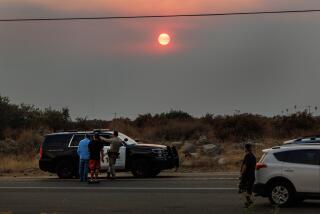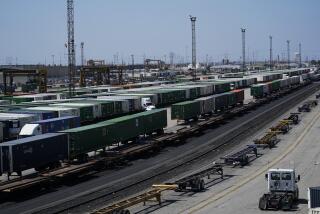Southern California expected to miss 2015 deadline to curb soot
Southern California is likely to miss a 2015 deadline to clean soot from the air, according to the region’s chief smog-fighting agency, which approved a plan Friday blaming the drought for reversing a long-term decline in fine-particle pollution.
The plan approved by the South Coast Air Quality Management District’s governing board on a 10-1 vote was criticized as weak by community activists and environmental groups. At a public hearing, they urged air quality officials to include stronger pollution controls to ensure the region meets the federal standard for fine particulate matter, or soot, on time.
“It is crucial that we do more,” Elizabeth Ayala, a Sierra Club member from Riverside told the board. “It is not sufficient that we wait for rain.”
Air quality officials said the delay in curbing soot is the result of California’s lingering drought, which has worsened pollution across the state. Fewer storms have blown in to sweep away dirty air and parched conditions have released more dust from the soil and roads, air quality officials said, boosting the number of bad air days and health advisories over the last two years.
The South Coast air district, which includes Los Angeles, Orange, Riverside and San Bernardino counties, was supposed to meet the federal fine-particle limit of 35 micrograms per cubic meter by the end of 2014, but a federal appeals court decision extended that deadline to 2015.
Meeting that standard by the end of this year is possible if pollution drops considerably, the air district’s plan says. But compliance is judged on a three-year-average and air quality officials acknowledged that poor air quality over two consecutive winters makes that very unlikely.
The agency could then ask for an extension until 2016 or 2017, but if the region remains out of compliance after that, it would be bumped up from “moderate” to “serious” status with the U.S. Environmental Protection Agency. That would trigger emissions cuts for some of the region’s largest facilities and require officials to tighten other clean-air regulations on industry.
Fine particle pollution, also called PM2.5, is of chief concern during the winter and made up of specks and droplets emitted from diesel engines, fires and formed from gases released during fuel combustion. The pollutants pose serious health risks because they are so tiny they are inhaled deep into the lungs, where they can impair breathing and damage the heart and blood vessels. Health studies link fine-particle pollution to thousands of early deaths in the state, most of them in Southern California.
While air quality monitors throughout the region exceed the federal government’s fine-particle pollution standard on a handful of days each winter, only one station in the Riverside County community of Mira Loma does so enough to violate the Clean Air Act, AQMD officials said.
To reduce fine particle levels, the South Coast air district has relied on “no-burn alerts” that prohibit residents from using wood-burning fireplaces when elevated pollution is forecast. Existing emissions rules, turnover of the vehicle fleet and upcoming regulations on industrial sources will also help reduce soot in the next few years, officials said.
As part of its action Friday, the air district’s governing board instructed staff to work with community groups to identify additional measures that could more quickly cut fine particle pollution.
Joseph Lyou, a AQMD board member who heads the nonprofit Coalition for Clean Air, said he would not support a plan that offered little certainty of soot levels reaching acceptable limits on time.
“What we have is something that might get us there if we’re lucky, if we catch a break,” Lyou said before casting the lone dissenting vote.
Twitter: @tonybarboza
More to Read
Sign up for Essential California
The most important California stories and recommendations in your inbox every morning.
You may occasionally receive promotional content from the Los Angeles Times.











